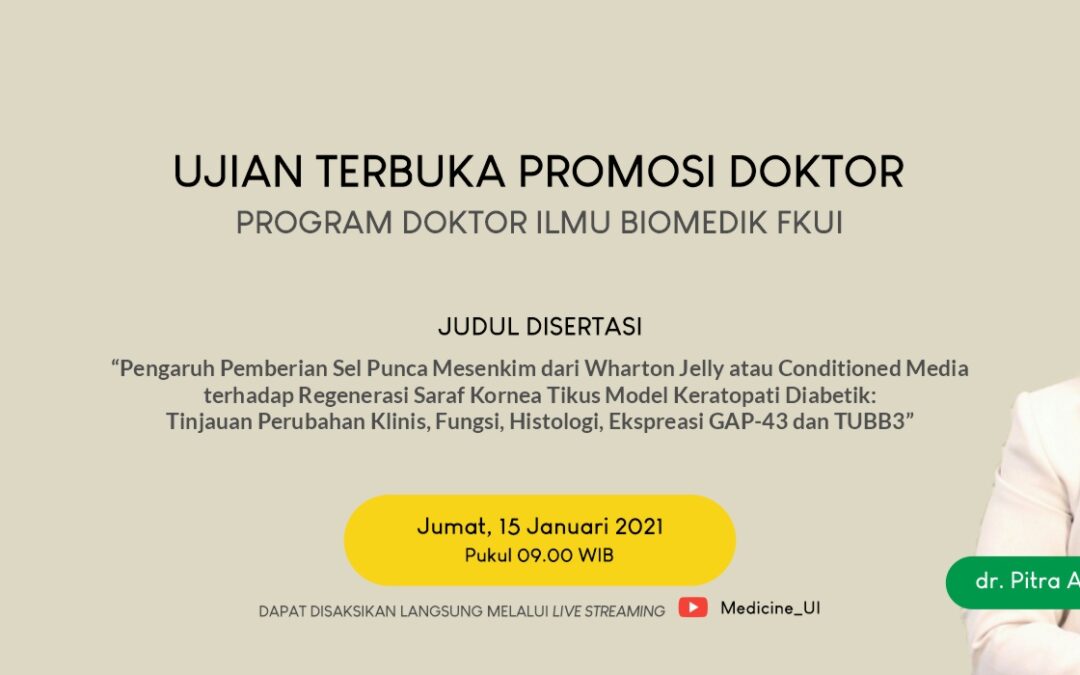Faculty of Medicine UI recently graduating dr. Pitra Ariesta Shinta Dewi, SpM, adding her to the growing list of its Biomedic Doctorate Program graduate. After her successful dissertation defence in open trial which conducted virtually in Friday, 15th of January 2021.
- dr. Pitra compose a dissertation titled “Pengaruh Pemberian Sel Punca Mesenkim dari Wharton Jelly atau Conditioned Media terhadap Regenerasi Saraf Kornea Tikus Model Ceratophaty Diabetik: Tinjauan Perubahan Klinis, Fungsi, Histologi, Ekspresi GAP-43 dan TUBB3” and able to answer any questions or rebuttal from the examiner team with dr. Radiana Dhewayani Anatrianto, M.Biomed, PhD at the helm, and dr. Nurjati Chairani Siregar, MS, Phd, SpA(K); Dr. dr. Made Susiyanti, SpMK(K); and guest examiner Dr. dr. Husnun Amalia, SpM(K) from Trisakti University.
Through her dissertation, Dr. dr. Pitra explained that Diabetes Melitus (DM) is a chronic metabollic disease with high morbidity and mortality in the world. Based on data extracted from International Diabetes Federation (IDF), Diabetes Melitus global prevelance expected to increase from 371 million lives in 2012 to 552 million lives in 2030. In 2010, Indonesia has the seventh largest DM patient in the world. World Health Organization (WHO) expecting Indonesia DM patient to be increased from 8,4 million lives to 21,3 million lives in 2019.
Diabetes Melitus disturbance, marked with hiperglikemia, changes in lipid metabolism, carbohidrate and protein, and increase risk of neurovascular disease complication. Example of DM complication in eyes, can be an abnormality in retina (retinopati diabetic), abnormality in lense (catarac diabetic), or abnormality in cornea structure (ceratophaty diabetic). Various research reported that ceratophaty diabetic complication prevelace ranging from 47-70% cases of Diabetes Melitus, whereas retinopati diabetic complication prevelance reported lower, ranging in 17,2% – 42,6%.
Ceratophaty diabetic marked with disturbance in cornea nerves system, which resulted in disturbing the cornea regeneration and causing decrease in cornea sensibility in DM patient’s. Progressive decrease of cornea’s sensibility leads to neuropati diabetic, significantly lowering the sight sharpness, even blindness.
Eye organs has a special sensor relatively separated from systemic circulation, this causes absorption and distribution of medicine to the eyes became its own challenge. One of the strategy to face this problem is through regiment selection and suitable medicine delivery.
Multiple studies reported topically punca mesenkim cell application in form of aye drops shows repair in clinical abnormality and able to overcome dry-eye syndrome. Administration of punca mesenkim cell eye-drops which comes from fat tissue is a non-invasive therapy for corneal tissue regeneration.
Punca mesenkim cell is one of many kinds punca cell which can be selected for regenerative therapy, because of its ability to regenerate and differentiate to different kinds of cell. This multipotent cell group can be isolated from ranges of mature network such as marrow, bones, fat tissue, and central rope including Wharton Jelly. Wharton Jelly based punca mesenkim cell has a well proliferation and regeneration ability by in vitro, has low imunogennity, and has a immunnosuppression potential which can prevent post-transplantation rejection reaction.
Conditioned media is a punca cell culture medium which contains bioactive result from cultured punca mesenkim cell such as nerve growth factor (NGF), stem cell factor (SCF), hepatocyte growth factor (HGF), and vascular endothelial factor (VEGF), that growth has a potential for nerve regeneration. Conditioned medium also contain extracellular vesicles (EVs) which contains different kinds of proteins, peptids, nucleic acid such as DNA and miRNA, and also lipid. Extracellular vesicles helps to stabilize the different kinds of particles, facilitating communication in between cell and has a function to stabilize growth factor. To prove its ability to regenerate eye cornea using punca cell, this research will test punca cell from wharton jelly and its CM’s to DM ceratophaty rat as a model animal.
Sprague-Dowley male rat, which used as a model animal later inducted to DM by injecting streptotozotocin (STZ) 50mg/KgBB. Rat’s blood sugar level and weight evaluated as long as 12 weeks, which then given topical punca mesenkim cell eye drops from Wharton Jelly and its CM to repair different kinds of abnormality in the ceratophaty DM rat’s cornea. Topical punca mesenkim cell given as many as 8 times, 1 drop every hour, every day until the 14th day. This research conducted with various examination including cornea clinical aspect, cornea morphology, and cornea nerve regeneration in DM Rat which suffers from ceratophaty diabetic.
Clinical aspect of eye’s cornea suffering from ceratophaty diabetic marked with damaged cornea epitel cell and low cornea sensibility. Cornea sensibility in ceratophaty diabetic measured with calculating nylon filamen (mm) used as stimulation to make the rat blink. The shorter the filamen equals to higher pressure needed to show lowering cornea sensibility. Topical administration of punca mesenkim cell eye drops from Wharton Jelly or its CM on a ceratophaty diabetic rat able to repair clinical condition of the cornea that is increasing cornea’s sensibility, repairing cornea’s damaged epitel structure and morphology ceratophaty diabetic and effectively inducing cornea’s nerve regeneration and also able to prevent clinical diabetic rat’s cornea condition decline.
Cornea morphology aspect examined by measuring thicness of different parts of cornea such as tebal stroma, tebal epitel, and the total amount of epitel layers and thicness of cornea. Each of the components measured and calculated from the upper edge to bottom edge of the epitel in left, right and central peripheral cornea using Image J application. In this research, administration of punca mesenkim cell eye drops from Wharton Jelly or its CM, effectively repairing cornea’s lesi and increasing the thicness of the central cornea epitel. Other than that, there are positive correlation between cornea sensibility repairement with edge of the nerve as it indicators that is Growth-associated protein-43 (GAP-43), in increase expression GAP-43 in mRNA level and abundance of GAP-43 protein expression in DM group’s cornea which has been given topical punca mesenkim cell eye drops from Wharton Jelly or its CM than other DM group without treatment.
Positive correlation also found betweet cornea sensibility repairement with beta tubulin III (TUBB3) nerve fiber regeneration as indicator, in increased expression of TUBB3 in mRNA level in DM groups which administered with topical CM punca mesenkim from Wharton Jelly and to abundance of TUBB3 protein expression in DM group given topical eye drop punca mesenkim cell from Wharton Jelly or its CM.
This research successfully proves that nerves disturbance is happening in ceratophaty diabetic cornea’s and followed by damaged cornea’s epitel layer which is the characteristics features from ceratophaty diabetic’s cornea. Significant cornea’s epitel layers decimation and sharp decline in total amount of cornea epitel cell caused by increased epitel cell apoptosis also a defining characteristics of ceratophaty diabetic. However, there are no evidence in this research. On the contrary, this research shows that in certain part of the cornea, such as perifer, epitel layer had thickens. Thickening epitel perifer layer located near limbus which indicate that punca cell or epitel cell progenitor is doing compensation action against apoptosis process.
This research also successfully proves topical administration of punca mesenkim cell from Wharton Jelly able to slowed down the decrease of cornea’s sensibility and suppress the damage in cornea epitel layer integrity. Administration of punca mesenkim cell or its CM also able to increase expression of nerves regeneration marker GAP-43 and TUBB3 if compared to DM control without action, this proves that punca cell able to suppress decrease in function and damage in cornea’s epitel cell layer integrity, also prevent dry eyes syndrome in ceratopathy diabetic cornea by fixing or increasing the cornea nerves regeneration ability. Although this research shows administration of punca mesenkim cell from Wharton Jelly or its CM with topical dose, frequency and simple formulation not yet able to return the cornea epitel layer integrity to normal.
Although this research able to proves that punca mesenkim cell from Wharton Jelly or its CM able to increase cornea’s nerves regeneration so it will be able to suppress the decrease in function and damage in cornea epitel layer integrity, but there is no conclusion yet as to how the mechanism works. Punca cell labeling (stem cell tracking) to know how much punca cell able to breach epitel barrier rat’s cornea diabetic ceratophaty is not conducted. Examination of the concentration of cytokines or local trophic factors that play a role in the process of regeneration of nerves or corneal cells, such as HGF, NGF, and KGF was also not carried out, so it needs to be examined in further research in order to obtain the effectiveness of stem cell or CM therapy which is more optimal for cases diabetic keratopathy. The promoter in this research is Prof. Dr. dr. Ratna Sitompul, SpM(K) with the co-promoter Prof. dr. Jeanne A. Pawitan, MS, PhD and Aroem Naroeni, DEA, PhD. At the end of the session, the chairman of the session who is also the Dean of FKUI Prof. Dr. dr. Ari Fahrial Syam, SpPD-KGEH, MMB, said, “Congratulations to Dr. dr. Pitra Ariesta Shinta Dewi, SpM, for her achievements. What’s more interesting is that his research is research that is currently being conducted worldwide, namely research on stem cells. And what makes us happy is that most of this research is carried out at IMERI FKUI. Starting from the Biomedical Center and Basic Health Technology, FKUI Experimental Animal Laboratory, in the Stem Cell and Tissue Engineering Cluster, at the Molecular Biology and Proteomic Core Facilities Cluster, at the Center for Health and Virology Service-Based Research Laboratory (PRVKP) FKUI and at the FKUI Integrated Laboratory. So I think this is in line with the initial goal of the establishment of IMERI FKUI, which is to produce researchers and superior products that are of course beneficial to the community.”

